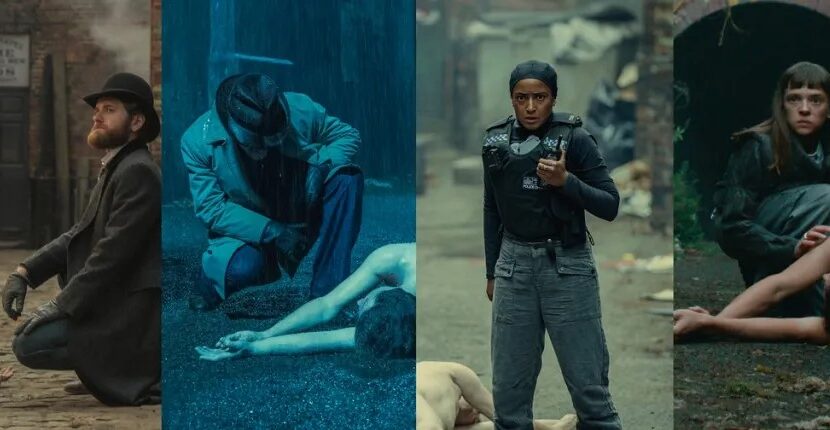BODIES. A Netflix Series I Want to Love, But Can’t [REVIEW]

“Bodies” is a serial adaptation of Si Spencer’s comic book series, featuring four detectives investigating the discovery of a man’s body in an alley in the London district of Whitechapel, specifically Longharvest Lane. Before dismissing the above description with the thought of not tolerating another “mystery” crime series, it is essential to know that “Bodies” offers much more. The deceased appears on Longharvest Lane in the years 1890, 1941, 2023, and 2053, and each of the four detectives investigating his death represents a different era. As one can easily guess, it quickly becomes apparent that there is something or someone connecting the cases beyond the titular bodies. Therefore, Paul Tomalin’s production promises a sum of all kinds of goodness, including murder, mystery, and – not a spoiler – time travel.
Promise
The promise is indeed a good word in the context of “Bodies.” The news of receiving an adaptation of Si Spencer’s comic series on time travel was already fantastic. Subscribers’ appetites were further sharpened by the trailer, which promised an emotionally engaging and staggering story. The first episode of “Bodies” turned out to be very interesting, skillfully arousing viewers’ curiosity and desire for further watching. The division of the screen into panels, reminiscent of a comic, to depict similar activities in the same places in different periods, impressive portrayals of Victorian and wartime London, clever use of practical effects, and intriguing outlines of detective characters effectively convinced me that Paul Tomalin and company knew exactly what they wanted to do with this story and how to continue it. In short, everything indicated a hit similar to “Dark.” Unfortunately, subsequent episodes of “Bodies” gradually broke the complex promise made by the creators.

Related:
London
However, before I delve into what disappoints me in ultimately loving “Bodies,” let’s focus on the things that make me regret that this series did not fulfill its initial promises. I already mentioned the impressive depictions of London from the past. In this context, it is worth noting the significant role Tomalin’s production assigns to this city. In “Bodies,” London is a sign of stability and permanence. Although the characters travel through time, London remains… London. This is evident in the series when the action takes place in 1890, 1941, and 2023. However, when the story involves Elias Mannix’s future utopia, the city seen from Sergeant Maplewood’s apartment windows seems entirely different, alien. This interesting technique is related to the concept of psychogeography.
Stephen Graham and the Rest Stephen Graham is an outstanding actor, and his performance in “Bodies” confirms that. Paul Tomalin was incredibly fortunate to have hired this artist for the role of Elias Mannix. The truth is that with relatively little screen time, Graham manages to convince the audience why his character often makes radical decisions. In fact, I would even venture to say that “Bodies” makes sense solely because of this actor’s performance. The other stars of the series bravely follow Graham. Jacob Fortune-Lloyd as Detective Whiteman from 1941 plays the egocentric chauvinist who hides his true identity well, Kyle Soller as Hillinghead excels as the uncompromising, just, and honorable homosexual law enforcer from 1890, Amaka Okafor shows that she is excellent as a tough policewoman whose origin often becomes the target of attacks in 2023, and Shira Haas as Sergeant Maplewood from 2053, struggling with a disability, convincingly battles with herself over choosing a utopia in bondage or a free dystopia.

Disappointment
Most of what I have written above would suggest that “Bodies” is a well-played Netflix series set in an impressive, soulful London presented on multiple temporal axes. True! I also wrote about promises that Tomalin’s hit made but failed to fulfill. It’s time to expand on this topic a bit. The division of the series into four eras and, by extension, four stories naturally leads to some viewers wanting to spend more time with characters representing, for example, Victorian London, and less with characters from the contemporary English capital, and vice versa. Despite the clear assertion that the main characters in “Bodies” are outsiders due to their origin, sexual orientation, or disability and should easily gain the audience’s sympathy due to their resilience against adversity, it’s hard to escape the feeling that some characters receive significantly more screen time, temporarily abandoning the threads of others. I would also add that, in my opinion, the time for much more interesting storylines is diminished. The narrative structure of “Bodies” deserves criticism in general. Although Tomalin’s production is labeled as a miniseries, it has a total of 8 episodes. In the first half of the season, we learn practically everything the creators wanted to convey, and the second half is spent going through the same events again, this time from the perspective of the main antagonist, whose motivations are absurd and would contribute to perceiving Mannix solely as a madman if not for Graham’s excellent performance. The series sometimes reaches a point where viewers know what will happen before the characters do. The above, as well as the creators’ complete silence on several issues begging to be expanded upon (such as the creation of Mannix’s utopia), suggest that “Bodies” could have been told in a much shorter format, which would likely have had a positive impact on the production. I also cannot fathom how, with such proficient use of practical effects, CGI could be treated so neglectfully. The computer-generated effects in “Bodies” are cheap and glaringly artificial.

Apart from excellent promotional materials, a brilliant idea for adapting Si Spencer’s comic, and a quite successful first episode, the greatest achievement of “Bodies” is that due to its theme of time travel, it can be compared to Netflix’s streaming masterpiece, “Dark.” However, that’s not enough to forever be remembered by all fans of complex series where creators play with temporal paradoxes.





